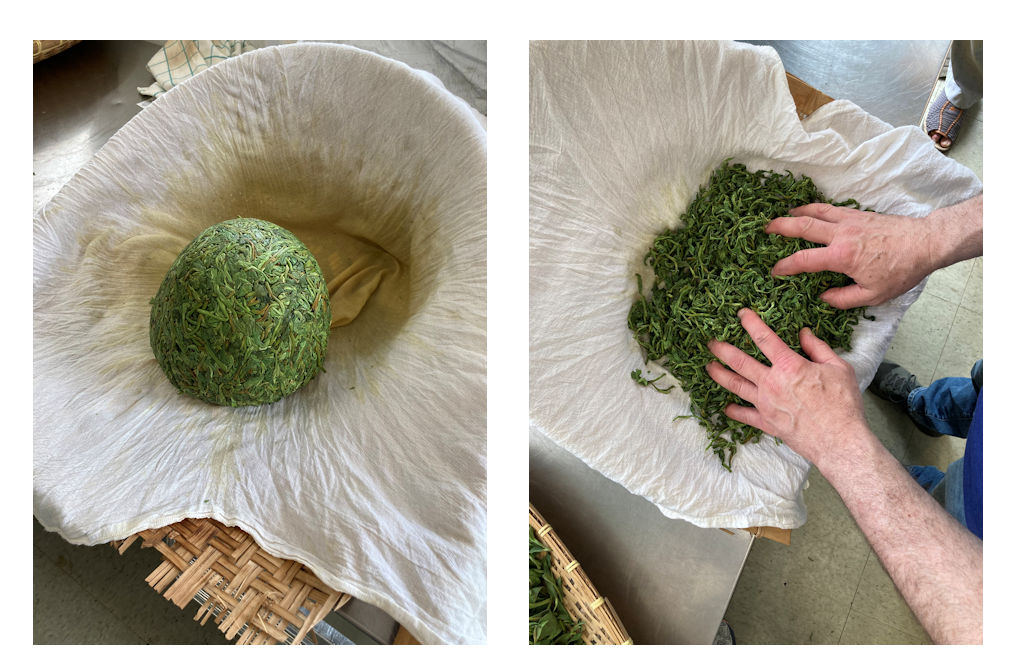Our success making green tea was the result of a series of Zoom talks we attended over the summer last year. The courses were offered by the US Tea Experience, a group led by the tea makers at the Great Mississippi Tea Company. The owners also offer training at their facility in Brookhaven in southern Mississippi. You can learn a lot from a well taught lecture, but hands-on experience is extremely valuable. We did get a large dose of experience with our first two green tea efforts but you never quite know if you are doing it right when you are doing a new task on your own. There are fine points you miss. Bad practices can take hold out of your ignorance. Spending time with someone who knows what they are doing seemed like a good next step.
We booked time for a farm visit and “tour” earlier this year. The farm operation is fairly compact so the tour part of our visit did not take long. The greatest part of our time was spent processing tea. The first lesson was making black tea. Our guide had harvested several pounds of leaf the night before we arrived. It had withered overnight. The wither for black tea is much longer than what is done when making green tea. A 40% decrease in leaf weight is the goal. Ideally this is done over 14 – 16 hours. A shorter wither will increase bitterness. The wither was completed by the morning of our visit so our first task was to roll the leaf. Rolling for black tea, like withering, is done for a longer period than with green tea production – typically 45 minutes or so. Rolling is done to prepare the leaf for the next step – oxidation. The leaf structure needs to be broken down to a greater degree so that more of the leaf substance is exposed to ambient oxygen. Oxygen causes browning. The length of time needed to adequate roll would be arduous if it were done by hand. The tea leaf rolling machine is key to getting this done. The links below will take you to two short YouTube videos of the rolling process.
Rolling tea by hand
The Tea Rolling machine

The rolled tea Breaking up the roll
Once rolling is completed, the leaf is spread onto pans and set aside to oxidize in a high heat and high humidity environment. This is the regular environment in traditional tea producing regions. The Mississippi tea makers use a bread proofing cabinet that will maintain the 90oF temperature and 90% humidity needed for proper oxidation. The leaf sits for several hours to complete this step.
With the black tea set aside for oxidation, we went to the field to pluck leaf for green tea production.

Plucking tea
Our green tea processing followed the steps outlined in a previous blog post. Our kill green step was done by pan firing the tea in a wok after withering. This was a great experience for all of us. I came away feeling pretty comfortable using this method on my own. The cost of the equipment is not high at around $100. The technique, like hand rolling, looks difficult but after several turns at the wok it became more comfortable. I like the flavors roasting imparts to the tea. Later in our visit we sampled an experimental batch of roasted oolong the tea makers were developing. It was quite good. That experience got me thinking that roasting might have a role in more than just green tea processing. For example, roasting black tea after oxidation before it goes to the drier might add an additional positive nuance to the final tea.

Pan fired tea
Once our black tea was adequately oxidized and our green tea pan firing was completed, both teas were placed into the tea drier

Loading the drier
to complete their processing. For fun, we pulled out a sample of oxidized but undried black tea. Our host brewed a pot of this tea. It had much of the flavor of black tea but not quit all. A later pot of the finished black tea turned up more roasted notes and a little greater intensity of flavor.
After a break for lunch, we were back plucking leaves to start a batch of oolong. Oolong production benefits from taking leaves further down the stem – down to the fourth of fifth leaf. This leaf processing involves a wither under sunlight to heighten flavor compound production. In a commercial production facility governed by safe food handling practices, the sun wither is conducted indoors under lighting that reproduces the needed UV spectrum (with bulbs in protective sleeves in case one breaks). Exposing the leaf to outdoor sunlight would also expose them to the risk of contamination by a bird flying by (or other unwanted material landing on the leaves). Before the day finished, the leaves went into a tumbling machine for a slow overnight oxidation with occasional leaf tumbling to develop the desired oolong flavors. Next morning the leaves are rolled. Rolling the more mature fourth and fifth leaves is more difficult due to the increased fibrous structure of these leaves. The leaf material is heated to make them pliable for proper rolling. A longer roll is needed to break up the tougher leaves. The leaves need to be reheated every 15 minutes or so to keep them pliable. That also contributes to lengthening the roll time. After rolling the tea is dried.

Bringing in the leaf
Our experience was enjoyable and very valuable. We gained great insight into how tea is made and also gained valuable hands-on experience working with tea leaves. A really great time.
